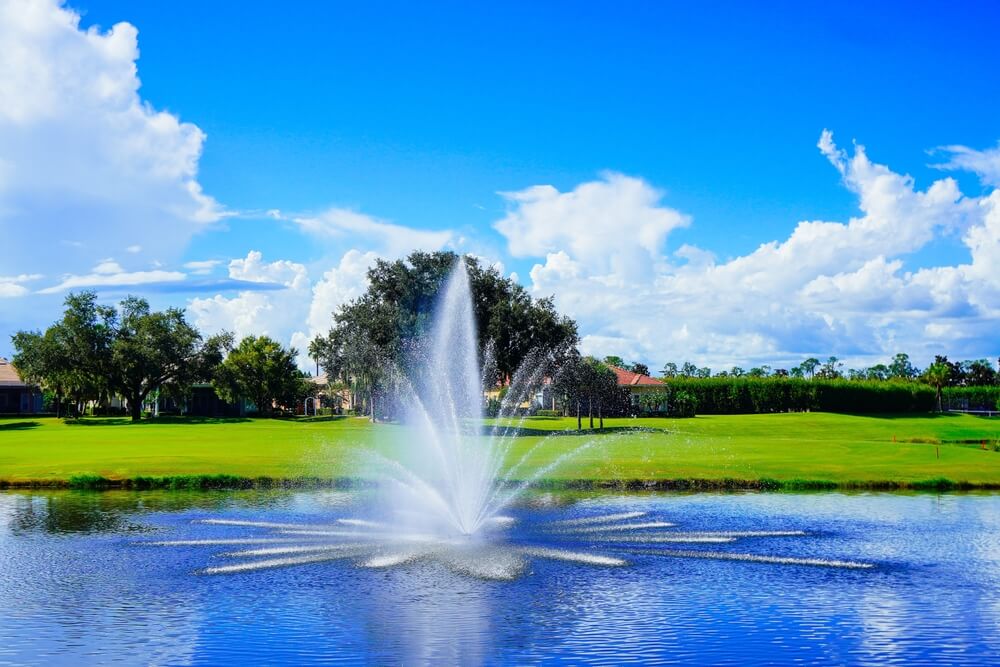
What’s in a spray pattern? Some would say that the nozzle is the most important piece of that puzzle, but the real secret is: maintenance.
A lake fountain can only perform as beautifully as it is cared for. When buildup, algae, and mineral deposits take over, even the best-designed fountain loses its sparkle. The difference between a neglected fountain and a well-maintained one is more than cosmetic. It's the difference between a struggling system and one that supports the health and beauty of your entire lake.
The Real Role of Lake Fountains
Fountains are more than a decorative feature. They play a key role in maintaining a balanced lake ecosystem. When operating correctly, they:
- Increase oxygen levels in the water, supporting fish and reducing unpleasant odors.
- Disrupt algae growth by improving circulation and reducing stagnant areas.
- Enhance clarity and appearance, keeping the lake surface clean and inviting.
A fountain is a living part of the lake system. When it is neglected, the results affect more than just its appearance.
What Happens When Maintenance Is Ignored
Neglecting fountain maintenance can create a chain reaction of problems. It often starts small. The spray might weaken, or you may notice an uneven pattern. Over time, these small issues can lead to larger ones, such as:
- Reduced water flow, which weakens the spray and limits aeration.
- Overworked pumps, increasing energy use and shortening equipment life.
- Clogged nozzles, creating uneven or broken spray patterns.
- Corrosion and wear, especially on metal fittings and cables.
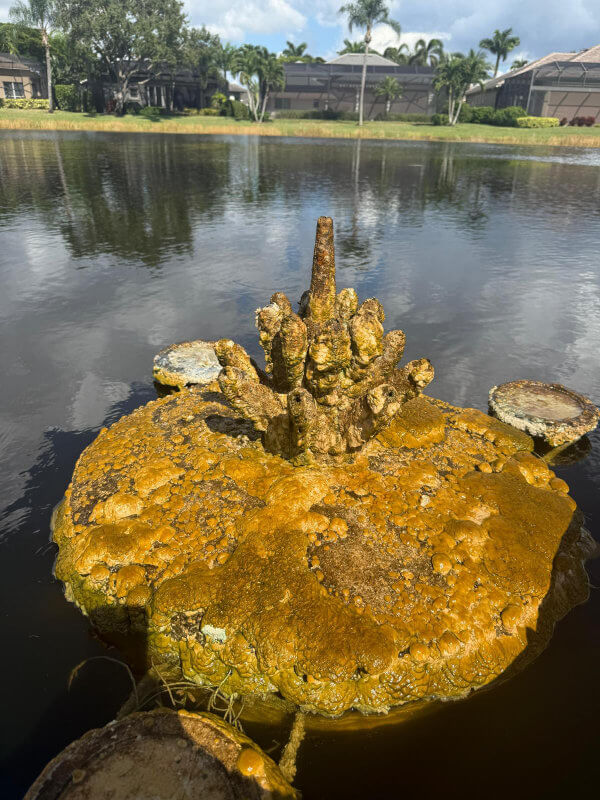
Oftentimes, what could have been a simple cleaning can turn into a major repair or full system replacement. In warm climates like Florida, algae and minerals build up quickly, making regular maintenance even more important.

For instance, take a look at this Bonita Springs fountain transformation. Over time, algae and buildup covered the float, nozzles, and cables, causing the spray to become uneven and lifeless. As the buildup worsened, the fountain lost the clean, balanced look that residents had come to enjoy. What was once a lively focal point of the community became a dull fixture that made the lake, and the surrounding area, look neglected.
The Payoff of Proper Fountain Maintenance
Routine fountain care keeps your equipment in top condition and performance steady throughout the year. A standard maintenance visit includes:
- Cleaning floats, nozzles, and screens to remove algae and buildup.
- Inspecting the pump and electrical components for proper function.
- Checking anchors and cables for safety and reliability.
- Testing and adjusting the spray pattern for height, shape, and balance.
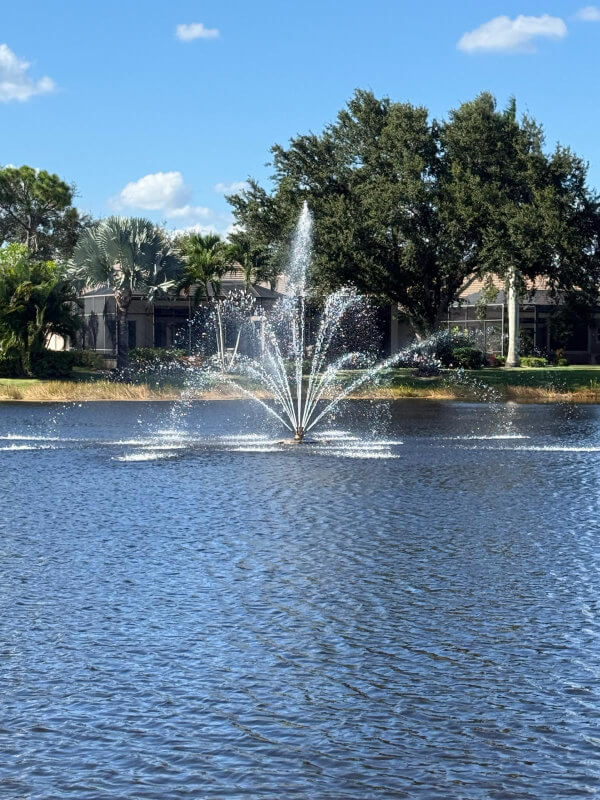
After servicing a fountain in great need of maintenance such as the one above, the difference is immediately noticeable. The spray returns to a clear, even pattern, and the fountain once again adds a clean, bright, and polished look to the lake. More importantly, the lake begins circulating properly again, which helps maintain better water quality and prevents future buildup.
How Often to Service Your Lake Fountain
Most fountains should be serviced every three to six months. The exact schedule depends on your lake’s conditions, including nutrient levels, water source, and sunlight exposure. Lakes with high organic material or frequent algae blooms benefit from quarterly maintenance.
Following a regular schedule prevents small issues from becoming costly problems. It also keeps your fountain looking beautiful year-round, which residents and visitors will appreciate.
The Environmental and Financial Benefits
Proper fountain maintenance benefits both your budget and the environment. A clean, efficient fountain uses less energy because the pump does not have to work as hard to push water through clogged nozzles. It also promotes natural water balance, which reduces the need for chemical treatments to control algae or odor.
Over time, these improvements save money, extend the lifespan of your equipment, and support a healthier ecosystem.
Protecting Your Community’s Image
Your lake fountain is often one of the first things people notice when they enter a neighborhood or community. It reflects the overall care and attention to detail of the property. A weak, unbalanced spray can make even a well-kept area look neglected, while a clean, symmetrical fountain adds pride and polish to the surroundings.
When maintained properly, your fountain becomes more than a visual feature. It becomes a symbol of your community’s commitment to quality, care, and environmental stewardship.
Keep Your Fountain Performing at Its Best
Whether your fountain needs a deep cleaning or ongoing care, Trademark Water Systems provides professional maintenance to keep your water features running smoothly and looking their best.
- Routine maintenance plans for communities and HOAs
- Pump and nozzle cleaning and inspection
- Algae and mineral removal
- Spray pattern adjustments and performance checks
Protect your investment and keep your lake beautiful, healthy, and clear.
Contact Trademark Water Systems to schedule your next maintenance visit and experience the difference proper care makes.
Don’t wait until your fountain shows signs of trouble. Schedule a maintenance visit today and see the difference a clean, well-tuned system can make for your lake!
Read Our Blog
Will City Water Kill Minnows? What Every Fish Owner Needs to Know
Learn how to prevent the chemicals in your water from killing your fish.
Should You Filter City Tap Water?
If you’re a Naples homeowner wondering whether your family should drink water straight from the tap or invest in a filter, you’re not alone. This guide breaks it all down in simple terms. You’ll learn how the city treats water, what might still be in it, and how to decide if a filter is worth it.

Why Your City Water Needs More Than Basic Treatment
Water flows through pipes and brings life to our homes. But what lurks beneath the surface? Our relationship with water runs deeper than most realize. Every shower, every glass, every splash in our...
